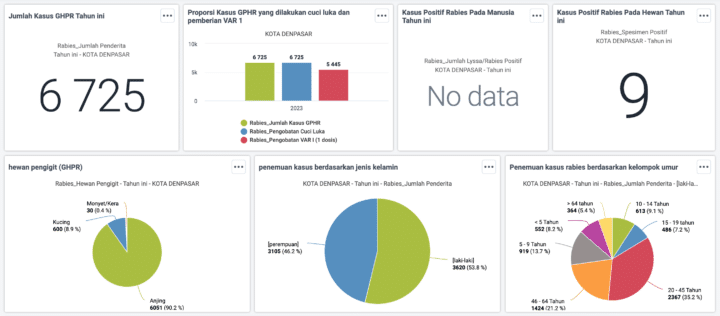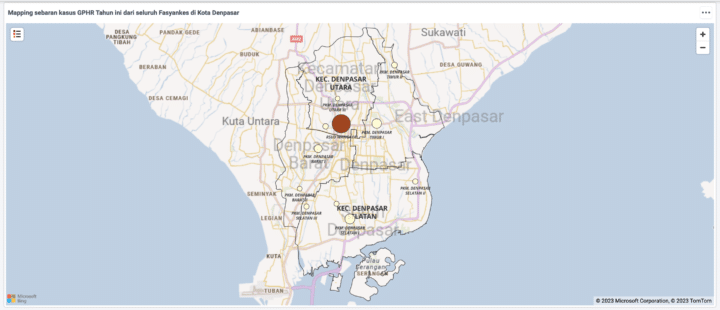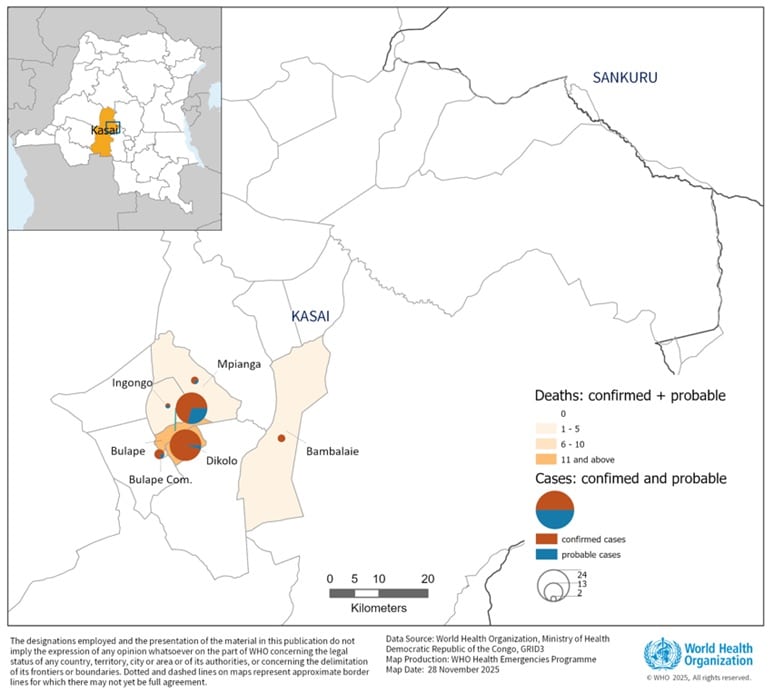
Indonesia adopted the One Health approach to integrate zoonotic disease tracking with national healthcare data using DHIS2
HISP Indonesia supported the Ministry of Health in implementing the national e-Zoonosis platform for emerging infectious and zoonotic diseases surveillance, facilitating case reporting, investigation, and logistics planning
Zoonotic diseases are communicable diseases that can spread between animals and humans. The WHO estimates that about “75% of recently emerging infectious diseases (EIDs) affecting humans were of animal origin; and approximately 60% of all human pathogens are zoonotic.” Southeast Asia has become a hotspot for the emergence and re-emergence of zoonotic diseases, such as the pathogenic avian influenza (H5N1), severe acute respiratory syndrome (SARS-CoV), Chikungunya virus, and most recently COVID-19.
Like most countries in the region, Indonesia has been severely affected by these outbreaks. In addition, its large size, population, and geographical diversity – with 274 million people spread over around 6,000 populated islands – make Indonesia susceptible to several other zoonotic diseases that pose challenges to public health. One example is rabies, which is endemic to 26 of its 34 provinces. Between 2020 and April 2023, an average of 82,634 cases of rabid animal bite cases per year were reported in Indonesia, causing the deaths of about 105 persons yearly. Similarly, other zoonotic diseases such as avian influenza, leptospirosis and anthrax have caused deaths and hospitalizations in the country through periodic outbreaks.
To tackle these challenges, the government of Indonesia adopted the One Health strategy, a concept that emphasizes the interconnectedness of human health, animal health, and environmental health. Beginning in 2018, Indonesia’s Ministry of Health, supported by HISP Indonesia, the HISP Centre at the University of Oslo and the Global Fund, introduced a national-scale electronic One Health platform based on DHIS2. This system was augmented in 2021 by the development of a custom e-Zoonosis application in DHIS2, with digital data collection using the Android app. This app was piloted in Denpasar, the capital city of Bali, where it has helped local, regional, and national health authorities to improve zoonotic disease surveillance and response, and has subsequently scaled across the country. So far, the system has supported monitoring and evaluation activities from the provinces up to the national level. Contact tracing and logistics management for rabies vaccines, serums and supplies have been enhanced by better quality data facilitated by the One Health platform.

The Indonesian One Health project: Localizing a global strategy towards health protection using DHIS2
As populations grow and humans interact more with the environments and other animals, cross infections and disease mutations have seen a rise in emerging diseases of zoonotic origins. Mindful of these threats, the government of Indonesia established a set of guidelines to monitor and manage zoonotic diseases of interest to the country in the Presidential Regulation 30/2011. This regulation identified 5 priority diseases – rabies, anthrax, bird flu, brucellosis and leptospirosis – and outlined measures that include a robust surveillance system to ensure early detection and response. Over time, this dovetailed into the development of an electronic platform for zoonotic disease surveillance called the Information System for Zoonotic and Emerging Infectious Disease (SIZE), in 2016. The SIZE platform integrated data from the ministries of Finance, Agriculture and Home Affairs to situate health financing, environmental and administrative data in a single platform for a broader view of healthcare inputs and their impacts. With the support of the University of Oslo in 2018, the MoH introduced a national One Health platform using DHIS2 for greater scale and interoperability in the surveillance of zoonotic diseases, EIDs and other health program data such as TB and malaria, among others.
The concept of “One Health” recognizes that the health of humans, animals, and the environment are closely linked and that addressing health challenges in one sector can have consequences in the others. In the One Health platform currently implemented in Indonesia, the country has made efforts to localize the system through language customizations on the DHIS2 forms as well as creating reference materials to simplify the processes and encourage greater utilization of the platform.

Local ownership of a national initiative to harmonize critical disease surveillance and enhance data use
Following the Mayor’s Decree 1/2015, a city-level policy guideline, the Denpasar City Health Office worked with the MoH and HISP officials to adapt the One Health platform for priority zoonotic diseases as well as non-zoonotic diseases like malaria, arbovirus, filariasis and worms. This led to the implementation of a custom city-wide DHIS2 e-Zoonosis platform called the DIREK Denpasar which integrates into the national One Health platform. In Bali, public health concerns of zoonotic origins range from rabies to influenza, leptospirosis, anthrax, and plague. Although rabies incidence in humans in the region has been on the decrease, the disease still constitutes public health challenges in the region with an average of 80,000 cases of bites by rabies-transmitting animals per year and an average of 68 deaths during the last three years. Between January and June 2023, the Bali Health Service reported that 19,035 individuals had been bitten by rabies-transmitting animals, resulting in 9 cases. Consequently, the region has successfully leveraged the One Health platform, through the DIREK Denpasar, to sustain effective surveillance and intervention planning.
When an individual presents at a health facility with an animal bite, he is offered wound treatment and rabies vaccine, while a laboratory examination is initiated. Concurrently, the facility data entry specialist records the reported bite cases into the DHIS2-based DIREK Denpasar using the Android app or facility-based computers, from where they are aggregated upwards in the national One Health platform. If the lab tests are positive for a zoonotic disease, the patient is immediately admitted into the hospital, while the rabies program collaborates with the facility surveillance team to investigate the case. This case investigation report will be included in the disease surveillance report to alert for potential outbreaks. Using the event data in DHIS2, epidemiological staff follow up with individual reported case and conduct contact tracing in the community with the view to timely case detection and control. During the survey, the epidemiologists visit the home of the infected individual recorded in DHIS2 either through the Android app or at the facility, to find out details of the case. Other homes close to the reported case are also visited. During this visit, the staff ask important questions such as the type of animal involved, the time and circumstances of the incident and whether other people have been bitten by the same animal. Relevant data about the infected animal and the circumstances of the bites are also collected using paper forms before they are entered into the DHIS2 platform at the facility level for subsequent aggregation through the organizational unit structure up to the national level.

The platform, which currently has 260 active uses, collects data on 53 different indicators from 13,180 organizational units across Indonesia. These indicators include reported cases of zoonotic disease of interest, test positivity rates, case fatality rates for the different diseases and stock data on anti-rabies vaccines and serum. They are presented in custom dashboards which are used to visualize the patterns and trends of tracked diseases for better decision-making. Currently, there are 8 DHIS2 dashboards used for visualizing various aspects of the reported data including health financing needs; relevant demographic information; incidences of zoonotic diseases and their associated epidemiologies; and vaccine stock levels and use. They are also used to monitor the actual action (cure/treatment) given to the patient including wound-cleaning vaccines administered. These dashboards are accessed at all organizational levels and are used to evaluate individual healthcare facilities during the monthly, quarterly and annual monitoring and evaluation exercises. The data is also leveraged to plan for efficient logistics, making sure the vaccines, serums and drugs are made available to facilities where they are needed the most at any given time.
Building the all-encompassing digital health ecosystem by integrating multiple program platforms into a single source of healthcare data in Indonesia
Currently, there are more than 400 different applications used to keep track of various healthcare programs across Indonesia. These applications collect a wide variety of information on health and diseases, including zoonotic diseases. The EID and zoonotic disease surveillance harmonizes data on relevant disease, health financing and logistics into a single e-Zoonosis platform, thereby providing a single source of complete information for intervention planning and outbreak response. Given the wide range of protocols and systems used for health data collection throughout the country, some systems are not able to transfer their data directly into the One Health platform, creating the need to use intermediary tools like MS Excel. The MoH therefore initiated measures to harmonize and standardize data reporting from all healthcare programs in the country into the One Health system through the ongoing interoperability platform in development. When complete, the interoperability platform will streamline the process of data transmission directly into DHIS2 and eliminate the need for data transcription with its attendant transcriptional errors.

This article is based on a presentation by HISP Indonesia at the 2023 DHIS2 Annual Conference. You can watch a recording on the DHIS2 YouTube channel.


